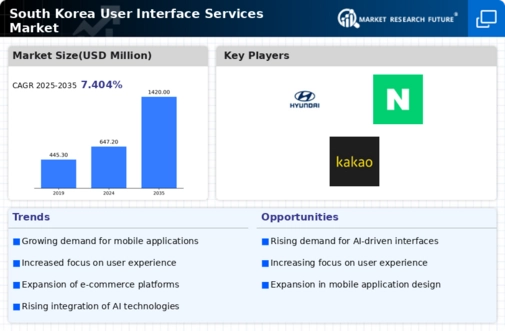Expansion of E-commerce Platforms
The user interface-services market in South Korea was significantly influenced by the rapid expansion of e-commerce platforms. With online retail sales projected to reach $100 billion by 2026, businesses are increasingly focusing on optimizing their user interfaces to enhance the shopping experience. A seamless and engaging interface is crucial for attracting and retaining customers in a competitive landscape. As a result, companies are investing in user interface design services to create visually appealing and user-friendly e-commerce websites and applications. This trend is further supported by the increasing adoption of digital payment solutions, which necessitate intuitive interfaces for secure transactions. The emphasis on user experience in e-commerce is likely to drive growth in the user interface-services market, as businesses seek to differentiate themselves through superior design.
Rising Demand for Mobile Applications
The user interface-services market in South Korea experienced a notable surge in demand for mobile applications. As smartphone penetration reaches approximately 95%, businesses increasingly prioritize mobile-friendly interfaces to enhance user engagement. This trend is driven by the growing reliance on mobile devices for daily activities, including shopping, banking, and social networking. Consequently, companies are investing in user interface design services to create intuitive and visually appealing applications. The market for mobile app development is projected to grow at a CAGR of around 15% over the next five years, indicating a robust opportunity for user interface-services providers. This rising demand underscores the necessity for businesses to adopt user-centric design principles, ensuring that applications meet the evolving expectations of tech-savvy consumers.
Emergence of Artificial Intelligence in Design
The user interface-services market in South Korea is increasingly influenced by the emergence of artificial intelligence (AI) technologies in design processes. AI tools are being utilized to analyze user interactions and preferences, enabling designers to create more personalized and adaptive interfaces. This integration of AI not only streamlines the design process but also enhances the overall user experience by providing tailored solutions. As businesses seek to leverage AI capabilities, the demand for user interface design services that incorporate these technologies is likely to grow. The potential for AI to revolutionize design practices suggests a transformative impact on the user interface-services market, as companies aim to stay ahead in a rapidly evolving digital landscape.
Increased Investment in User Experience Research
The user interface-services market in South Korea is witnessing a marked increase in investment directed towards user experience research. Companies are recognizing the importance of understanding user behavior and preferences to create effective interfaces. This trend is reflected in the growing allocation of budgets towards user testing, surveys, and analytics, which inform design decisions. As businesses strive to enhance customer satisfaction and loyalty, the demand for user interface design services that incorporate user feedback is likely to rise. This investment in user experience research is expected to contribute to a more competitive landscape, as organizations leverage insights to differentiate their offerings in the user interface-services market.
Government Initiatives for Digital Transformation
In South Korea, government initiatives aimed at promoting digital transformation are playing a pivotal role in shaping the user interface-services market. The government has launched various programs to encourage businesses to adopt digital technologies, which includes enhancing user interfaces across sectors. These initiatives are designed to improve efficiency and accessibility, thereby fostering a more competitive business environment. As a result, companies are increasingly seeking user interface design services to comply with regulatory standards and meet user expectations. The government's focus on digital innovation is expected to drive a growth rate of approximately 10% in the user interface-services market over the next few years, as organizations invest in modernizing their digital platforms.














Leave a Comment